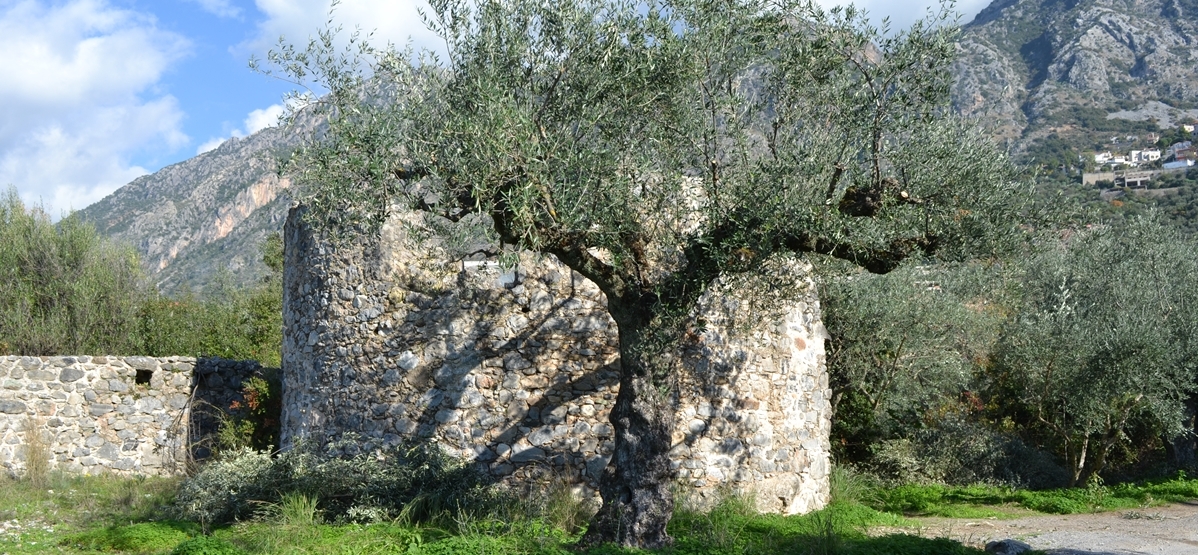WALL OF VERGA

Above is a photograph of the remaining ruins of one of the towers of the Wall of Verga
PLEASE NOTE THAT ALL THE PHOTOGRAPHS ON THE SITE ARE CLICKABLE LINKS

Above is a photograph of the remaining ruins of one of the towers of the Wall of Verga
PLEASE NOTE THAT ALL THE PHOTOGRAPHS ON THE SITE ARE CLICKABLE LINKS
**I have placed this page under the heading of Castles as the Wall was built for defence**
The Wall of Verga is situated 7 km east of Kalamata at a coastal location. It was a fortification that was built hastily by the Maniates (the inhabitants of Mani) in 1826 to repel the forces of Ibrahim Pasha.
The wall was named Verga meaning stick because it was long and narrow. At the same location, there was an older wall that was probably built also by the Maniates in the previous centuries to prevent Turks from entering their region. The settlement took the name Verga after the battle.
In the same area there existed a similar wall built for the same purpose, traces of which are no longer evident.
The later wall extends along the Almyros gorge, from the foot of a steep mountain near Kato Selitsa village to the sea. The wall was approximately 1500 metres long and is built on one side of the Almyros Gorge which makes it very inaccessible.
This point was the only easy passage from Kalamata to the Mani region and it is considered the gate of the Mani.
The fortification of Verga was a simple stone wall, 2m tall with two towers (one at each end) equipped with small canons and loop holes to look for the enemy and to fire through.
Just before the beach of Almyra is a monument of a Maniat warrior erected in memory of "those who fell in the cause of Greek freedom". The Wall of Verga is just behind this monument.
The Ottoman-Egyptian Invasion of the Mani was a campaign during the Greek War of Independence that consisted of three battles. The Maniots fought against a combined Egyptian and Ottoman army under the command of Ibrahim Pasha of Egypt.
Ibrahim sent an envoy to Mani in June 1826 demanding its surrender or else he would pillage it. He received the Maniot reply of:
"From the few Greeks of Mani and the rest of Greeks who live there to Ibrahim Pasha. We received your letter in which you try to frighten us saying that if we don't surrender, you'll kill the Maniots and plunder Mani. That's why we are waiting for you and your army. We, the inhabitants of Mani, sign and wait for you."
Ibrahim, furious with the response, ordered an attack on northwestern Mani from Kalamata on June 23, 1826.
Under his command was a force of 7,000 men, a mixture of infantry and cavalry. The invaders were forced to stop at the fortifications of the Maniots at Vergas near Almyra . Defending the walls were 2,000 Maniot soldiers and 500 Greek refugees.
The Egyptian artillery failed to breach the walls, so Ibrahim decided to launch two ships with cannons and have them bombard the Maniot defences from the sea. He also combined this attack with infantry assaults, however these failed as the invaders were driven back from the walls eight times.
The attacks lasted three more days before the Egyptians and Ottomans were forced to retreat when news arrived that Kolokotronis was approaching their rear with 2,000 men. The Maniots chased the Egyptians up to Kalamata before withdrawing. Ibrahim lost 2,500 men at Vergas and the Greek losses are unknown.
During the Battle of Verga, Ibrahim decided to attack the Maniots from the rear. His plan was to send a small fleet with a few soldiers to land at the Bay of Diros, 2 kilometers south of Areopolis. The aim of this was to capture the unguarded Areopoli.
This would cut the communication lines of the defenders at Verga and demoralize them as well. He would then be able to attack the Maniots from the rear and control the mountain passes to eastern Mani and Gytheio. On June 26, he sent a small fleet carrying 1,500 to land at the Bay of Diros. This force was initially successful; however they were repelled with heavy losses.
The surviving Egyptians were rescued by Ibrahim's fleet from the beach and those who were not rescued had to swim to the ships or be killed by the Maniots many of them women. This battle cost Ibrahim 1,000 men and he was forced to retreat from Mani after being defeated at Vergas.
Even though this campaign is overshadowed by other battles of the revolution, it was one of the most important. The Maniates stopped the Egyptians and Ibrahim Pasha who had not been defeated this decisively before.
The women who defeated the Egyptians at Diros have been given the name of 'The Amazons of Diros'. This was the last invasion of Mani as Ibrahim abandoned any ideas of conquering it. On April 26, 1827 the Turkish navy bombarded Oitylo with over 1,700 cannonballs hitting the town.
On the 20th October 1827, the combined fleets of France, England and Russia defeated the combined Ottoman-Egyptian fleet in the Battle of Navarino. Thus effectively bringing an end to the Ottoman Occupation as in 1828, under the terms of the Treaty of Constantinople, Greece became an independent state which was recognized by the Ottomans in 1829.